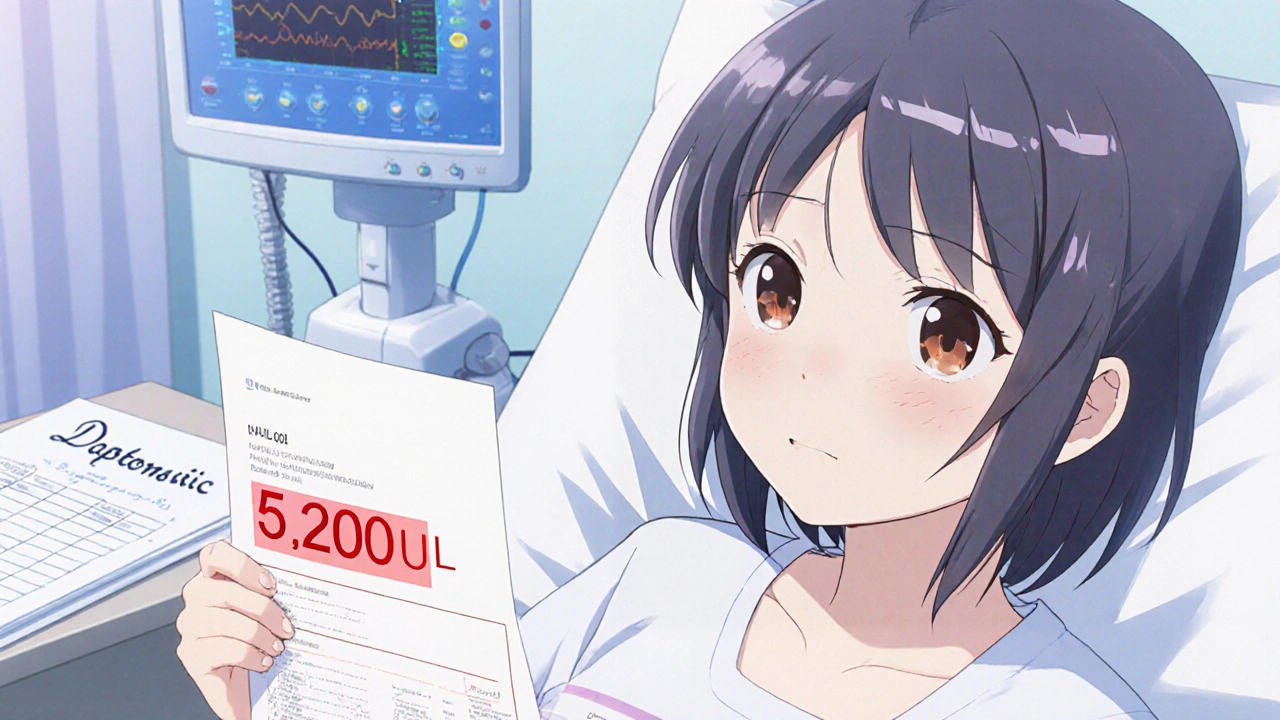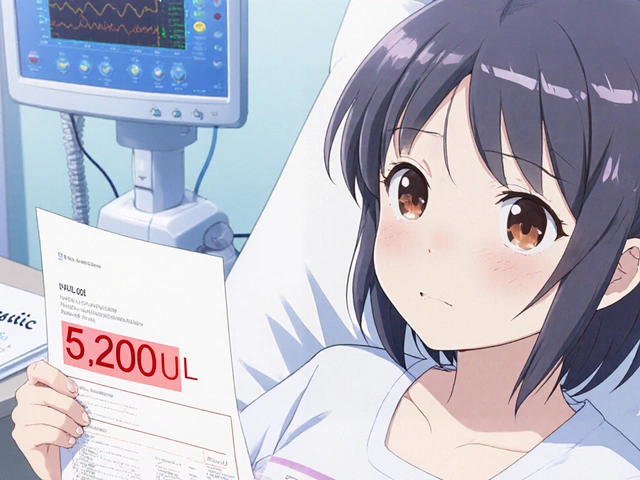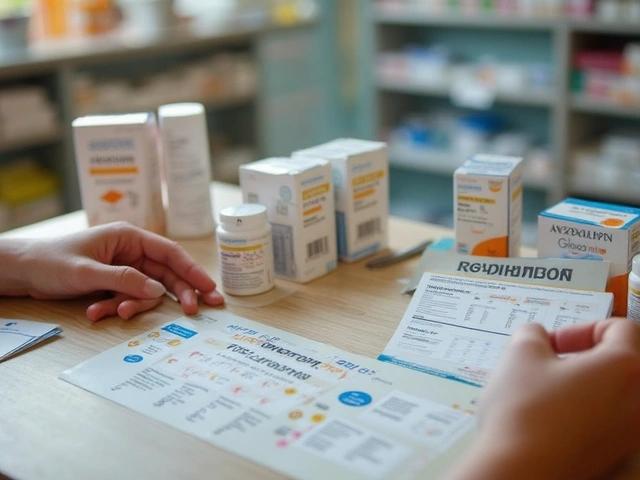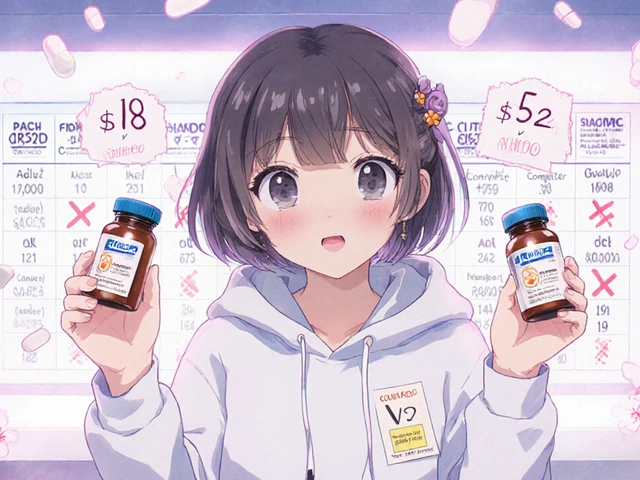Daptomycin CK Level Assessment Tool
CK Level Assessment
Enter your creatine phosphokinase (CK) level in U/L to determine your risk level and next steps.
What This Means
Normal CK levels: 30-200 U/L (men), 20-150 U/L (women)
Your Results
Based on clinical guidelines from University of Nebraska Medical Center
Daptomycin is a powerful antibiotic used to treat serious infections caused by resistant bacteria like MRSA-especially when other drugs fail. But it comes with a hidden risk: muscle damage. Unlike side effects you can easily feel, like nausea or dizziness, daptomycin’s most dangerous reaction often shows up silently in your blood before you feel any pain. That’s why checking your creatine phosphokinase (CK) levels isn’t optional-it’s life-saving.
What Happens When Daptomycin Damages Muscle?
Daptomycin works by punching holes in bacterial cell membranes. Unfortunately, it doesn’t always distinguish between bad bacteria and your own muscle cells. Studies show it directly attacks skeletal muscle tissue, causing cells to leak proteins like CK into the bloodstream. This isn’t just a lab anomaly-it’s early warning signs of muscle breakdown.
At first, you might not notice anything. But as muscle cells die, you could start feeling:
- Deep, persistent muscle pain-especially in thighs, shoulders, or back
- Weakness that doesn’t improve with rest
- Tenderness when touching your arms or legs
- Dark, tea-colored urine (a sign of myoglobin release)
These symptoms don’t always appear together. Some people feel nothing until their CK level hits 3,000 U/L or higher. That’s why waiting for symptoms to show up is risky. By then, you could already be heading toward rhabdomyolysis-a condition where muscle tissue breaks down so badly it floods your kidneys and can cause permanent damage or death.
Why CK Monitoring Is Non-Negotiable
CK is a protein found mostly in muscle. When muscle cells break down, CK spills into the blood. The higher the CK level, the more damage has occurred. Normal CK levels range from 30 to 200 U/L for men and 20 to 150 U/L for women. Anything over 1,000 U/L is a red flag. Over 5,000 U/L means severe muscle injury.
Guidelines from the University of Nebraska Medical Center say you should get a CK test every week while on daptomycin. If you’re on a higher dose-for example, 8-12 mg/kg for bone infections-you may need testing twice a week. Don’t wait for symptoms. Don’t skip a week because you feel fine. Muscle damage can creep up quietly.
Here’s what to do based on your CK levels:
- CK 1,000-4,999 U/L with muscle pain or weakness → Stop daptomycin immediately
- CK 5,000-9,999 U/L even without symptoms → Stop daptomycin
- CK ≥10,000 U/L → Stop daptomycin and get emergency care. This level carries high risk of kidney failure.
Even if you feel fine, if your CK is over 10 times the upper limit of normal (around 1,500-2,000 U/L depending on your baseline), you should stop the drug. This isn’t a suggestion-it’s standard protocol backed by clinical evidence.
Who’s at Highest Risk?
Not everyone on daptomycin gets muscle toxicity. But some people are far more vulnerable.
Higher doses-Doctors sometimes use 8-12 mg/kg for bone and joint infections because lower doses don’t penetrate well. But studies show myotoxicity jumps from 5% at 6 mg/kg to over 10% at 10 mg/kg. If you’re on one of these off-label doses, you’re in the danger zone.
Low oxygen levels-A 2020 lab study found daptomycin’s muscle damage gets dramatically worse under low-oxygen conditions. That means if you have heart disease, lung disease, sepsis, or poor circulation, your risk isn’t just higher-it’s multiplied. If you’re on daptomycin and you’re struggling to breathe or your limbs feel cold, talk to your doctor immediately.
Older adults-People over 65 have less muscle mass and slower kidney clearance. Daptomycin builds up in their system longer, increasing exposure. They also often take other drugs that can add to the risk.
People on statins-For years, doctors assumed combining daptomycin with cholesterol drugs like atorvastatin was dangerous. But a 2014 study of 220 patients found no statistically significant increase in CK spikes or muscle pain when statins were continued. Still, many clinicians still pause statins as a precaution. If you’re on both, ask whether stopping your statin temporarily makes sense for you.

What Happens After You Stop Daptomycin?
The good news? Daptomycin-induced muscle damage is almost always reversible.
Once you stop the drug, CK levels typically drop by 50% within 48 hours. Muscle pain and weakness usually improve within a week. Full recovery can take 2-6 weeks, depending on how high the CK went and how long you were exposed.
But if you ignore the warning signs and keep going? You risk kidney failure. When muscle cells break down, they release myoglobin-a protein that clogs kidney tubules. This can lead to acute kidney injury, dialysis, or even death. In one case report, a patient with heart disease developed a CK level of 6,250 U/L after just 10 days on daptomycin. He needed intensive care and nearly lost his kidneys.
How Daptomycin Compares to Other Antibiotics
Daptomycin isn’t the only antibiotic that can hurt muscles-but it’s different from the rest.
| Antibiotic | Type of Muscle Damage | Monitoring Needed | Reversibility |
|---|---|---|---|
| Daptomycin | Direct myopathy, CK elevation | Weekly CK tests | Usually complete |
| Vancomycin | Minimal muscle toxicity | Trough level monitoring | N/A |
| Fluoroquinolones (e.g., ciprofloxacin) | Tendon rupture, not CK rise | None routine | Often incomplete |
| Statins (cholesterol drugs) | Myopathy, CK elevation | Periodic CK if symptoms | Usually complete after stopping |
Vancomycin is cheaper and safer for muscles, but it requires frequent blood tests to check drug levels and can cause kidney damage over time. Fluoroquinolones don’t raise CK, but they can cause permanent tendon tears. Daptomycin’s risk is specific, predictable, and preventable-with the right monitoring.

Real-World Risks vs. Clinical Trial Numbers
You might see the FDA label say muscle toxicity happens in only 0.2% of patients. That number is misleading. It comes from early trials with healthy volunteers and strict dosing rules. In real hospitals, where patients are sicker, older, on higher doses, and have other conditions, the rate jumps to 5-10%.
Why the difference? Clinical trials exclude people with kidney disease, heart failure, or those on multiple medications. Real patients don’t fit that profile. If you’re on daptomycin because you have a prosthetic joint infection, sepsis, or a history of heart disease, your risk is far higher than what the label suggests.
That’s why your doctor should be talking to you about CK monitoring before you even start the drug-not after you feel pain.
What You Can Do Right Now
If you’re currently taking daptomycin:
- Ask for your last CK result-and make sure it was done within the last 7 days
- Keep a notebook: write down any new muscle pain, weakness, or dark urine
- Don’t assume your doctor knows your full history. Tell them if you have heart disease, COPD, or take statins
- If you’re on a dose higher than 6 mg/kg, ask if your CK is being checked twice a week
If you’re about to start daptomycin:
- Get a baseline CK test before the first dose
- Ask if your hospital has a written protocol for daptomycin monitoring
- Know the warning signs and don’t wait for them to get worse
There’s no magic pill to prevent daptomycin’s muscle damage. But you can stop it in its tracks-with awareness, testing, and timely action.
Can daptomycin cause permanent muscle damage?
In most cases, no. Muscle damage from daptomycin is reversible if caught early. Once the drug is stopped, CK levels drop quickly, and muscle strength returns within weeks. But if muscle breakdown is allowed to progress unchecked, it can lead to rhabdomyolysis, which may cause lasting kidney damage. The key is early detection through CK monitoring.
How often should CK levels be checked during daptomycin treatment?
Weekly testing is the standard recommendation. For patients on higher doses (8-12 mg/kg) for bone or joint infections, testing twice a week is advised. Testing should begin before the first dose and continue throughout treatment-even if you feel fine. Stopping testing after a week or two increases the risk of missing dangerous elevations.
Do I need to stop my statin if I’m on daptomycin?
The evidence is mixed. A 2014 study of 220 patients found no statistically significant increase in muscle toxicity when statins were continued with daptomycin. However, many clinicians still recommend pausing statins as a precaution, especially if you’re on a high daptomycin dose or have other risk factors like kidney disease or heart failure. Talk to your doctor about your individual risk.
What if my CK is high but I don’t have any symptoms?
You should still stop daptomycin. Muscle damage can be silent until it’s severe. Guidelines recommend discontinuing the drug if CK exceeds 10 times the upper limit of normal-even without pain or weakness. Waiting for symptoms could mean missing the window to prevent kidney injury.
Can daptomycin cause other side effects besides muscle damage?
Yes. Daptomycin can cause eosinophilic pneumonia, a rare but serious lung condition with symptoms like fever, cough, and shortness of breath-especially in patients treated for bone infections. It can also cause diarrhea, rash, or changes in liver enzymes. But muscle toxicity remains the most common and dangerous side effect requiring active monitoring.







